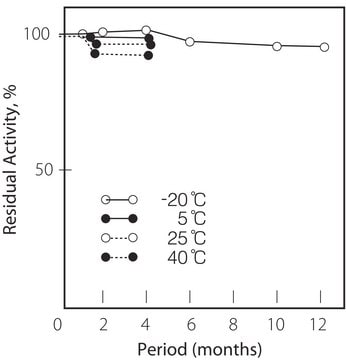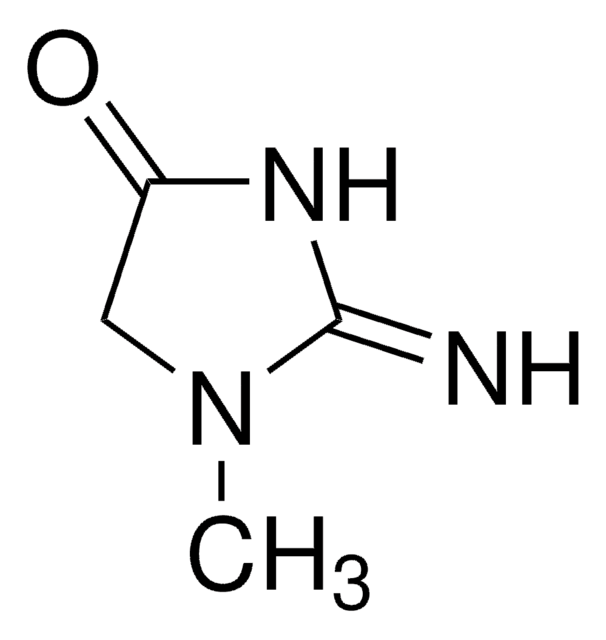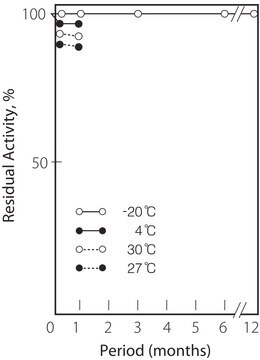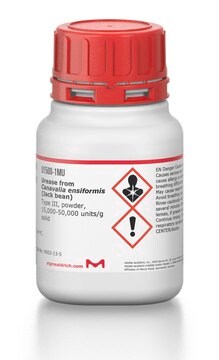Wszystkie zdjęcia(7)
Kluczowe dokumenty
C2409
Creatinase from microorganisms
lyophilized powder, ≥4 units/mg solid
Synonim(y):
Creatine Amidinohydrolase
Zaloguj sięWyświetlanie cen organizacyjnych i kontraktowych
About This Item
Numer CAS:
Numer WE:
Numer MDL:
Kod UNSPSC:
12352204
NACRES:
NA.54
Polecane produkty
pochodzenie biologiczne
bacterial (Actinobacillus spp.)
Poziom jakości
Formularz
lyophilized powder
aktywność właściwa
≥4 units/mg solid
masa cząsteczkowa
~100 kDa
temp. przechowywania
−20°C
Opis ogólny
Creatinase is a homodimer that catalyzes hydrolysis of creatine. It consists of two monomer subunits and two defined domains; N and C terminal domains. The C-terminal fold has both the α helices and anti-parallel β sheet within two structurally similar domains.In between these two domains, a sulfhydryl group acts as active site, and the activity is metal-independent.
Zastosowanie
Creatinase mixed with sarcosine oxidase may be used to determine the level of creatine in different pH, temperature, enzyme ratio, and buffer concentration. It may also be used to determine the plasma creatinine level by using a centrifugal analyser.
Działania biochem./fizjol.
Creatinase accelerates the conversion reaction of creatine and water molecule to sarcosine and urea. It always acts in homodimer state and is induced by choline chloride.
Właściwości fizyczne
Isoelectric point: 4.6 ± 0.1
Michaelis constant: 1.9 x 10‾2M (Creatine)
Structure: 2 subunits per mole of enzyme
Inhibitors: Cu++, Hg++, Ag+
Optimum pH: 8.0
Optimum temp: 40°C
pH Stability: pH 5.5 − 9.0 (25°C, 16hr)
Thermal stability: Below 50°C (pH 7.5, 30 min)
Michaelis constant: 1.9 x 10‾2M (Creatine)
Structure: 2 subunits per mole of enzyme
Inhibitors: Cu++, Hg++, Ag+
Optimum pH: 8.0
Optimum temp: 40°C
pH Stability: pH 5.5 − 9.0 (25°C, 16hr)
Thermal stability: Below 50°C (pH 7.5, 30 min)
Definicja jednostki
One unit will hydrolyze 1.0 μmole of creatine to urea and sarcosine per min at pH 7.5 at 37 °C.
Postać fizyczna
Lyophilized powder containing sugars and EDTA as stabilizers
Ta strona może zawierać tekst przetłumaczony maszynowo.
Hasło ostrzegawcze
Danger
Zwroty wskazujące rodzaj zagrożenia
Zwroty wskazujące środki ostrożności
Klasyfikacja zagrożeń
Resp. Sens. 1
Klasa zagrożenia wodnego (WGK)
WGK 1
Temperatura zapłonu (°F)
Not applicable
Temperatura zapłonu (°C)
Not applicable
Środki ochrony indywidualnej
Eyeshields, Gloves, type N95 (US)
Wybierz jedną z najnowszych wersji:
Masz już ten produkt?
Dokumenty związane z niedawno zakupionymi produktami zostały zamieszczone w Bibliotece dokumentów.
Klienci oglądali również te produkty
Balasundaram Padmanabhan et al.
Acta crystallographica. Section D, Biological crystallography, 58(Pt 8), 1322-1328 (2002-07-24)
The crystal structure of Actinobacillus creatine amidinohydrolase has been solved by molecular replacement. The amino-acid sequence has been derived from the crystal structure. Crystals belong to space group I222, with unit-cell parameters a = 111.26 (3), b = 113.62 (4)
H Crocker et al.
Journal of clinical pathology, 41(5), 576-581 (1988-05-01)
An enzymatic kit method for the determination of plasma creatinine was optimised for use with a centrifugal analyser and its performance characteristics and practicability compared with an end point and a kinetic Jaffé-based method. The enzymatic method exhibited several advantages
J F Bazan et al.
Proceedings of the National Academy of Sciences of the United States of America, 91(7), 2473-2477 (1994-03-29)
Amino acid sequence comparison suggests that the structure of Escherichia coli methionine aminopeptidase (EC 3.4.11.18) and the C-terminal domain of Pseudomonas putida creatinase (EC 3.5.3.3) are related. A detailed comparison of the three-dimensional folds of the two enzymes confirms this
Pinar Esra Erden et al.
Artificial cells, blood substitutes, and immobilization biotechnology, 34(2), 223-239 (2006-03-16)
A new enzyme electrode for the determination of creatine was developed by immobilizing creatinase (CI) and sarcosine oxidase (SO). The enzymes were co-immobilized in a poly(vinylferrocenium) matrix onto the surface of a platinum working electrode. Crosslinking with glutaraldehyte (GA) and
Jason A Berberich et al.
Acta biomaterialia, 1(2), 183-191 (2006-05-17)
The enzyme creatine amidinohydrolase is a clinically important enzyme used in the determination of creatinine in blood and urine. Continuous use biosensors are becoming more important in the clinical setting; however, long-use creatinine biosensors have not been commercialized due to
Nasz zespół naukowców ma doświadczenie we wszystkich obszarach badań, w tym w naukach przyrodniczych, materiałoznawstwie, syntezie chemicznej, chromatografii, analityce i wielu innych dziedzinach.
Skontaktuj się z zespołem ds. pomocy technicznej






